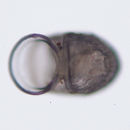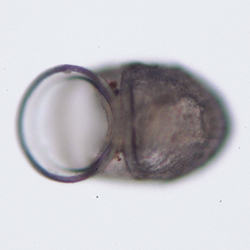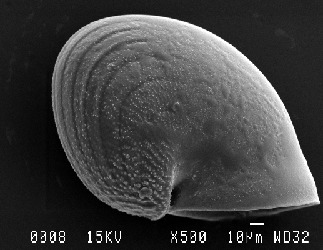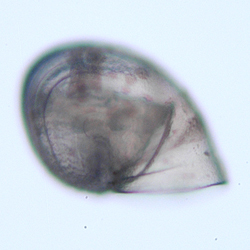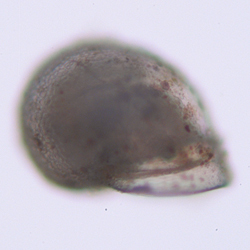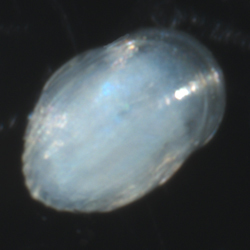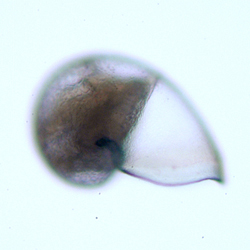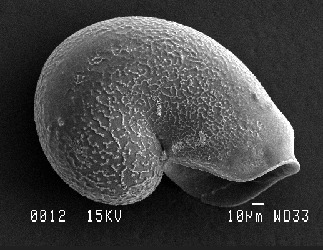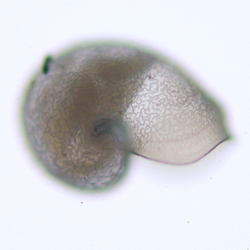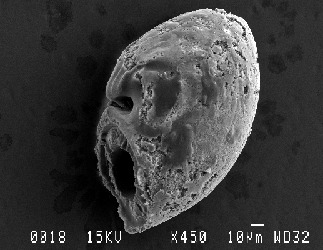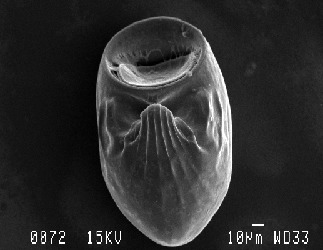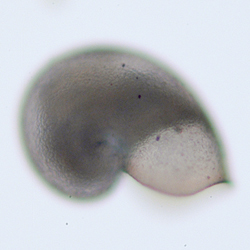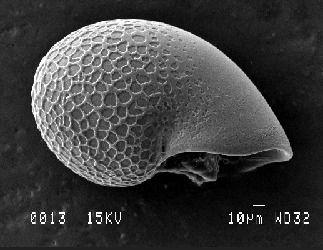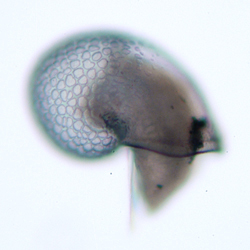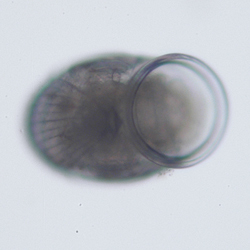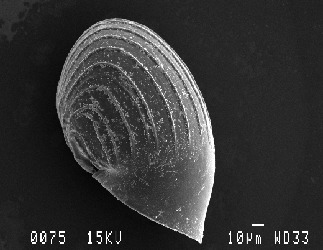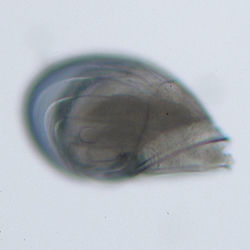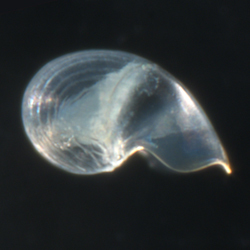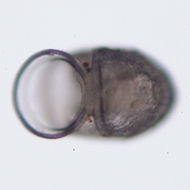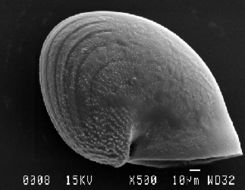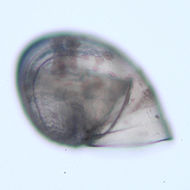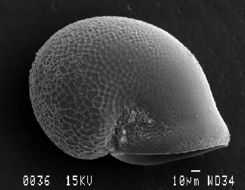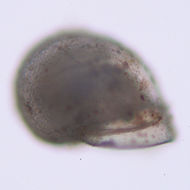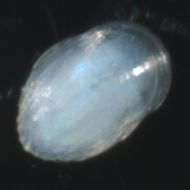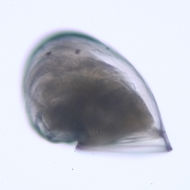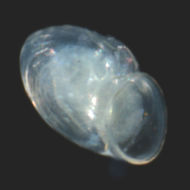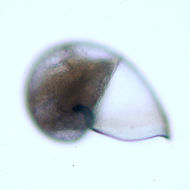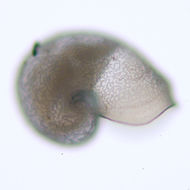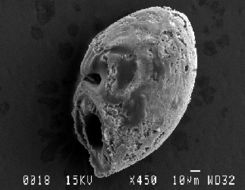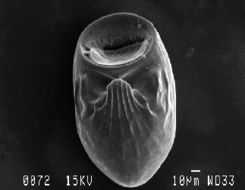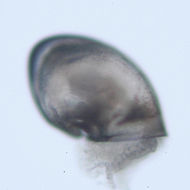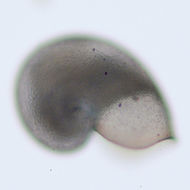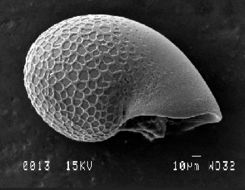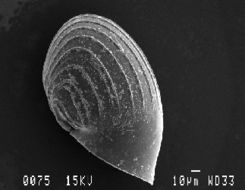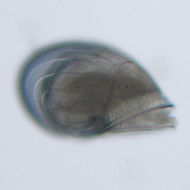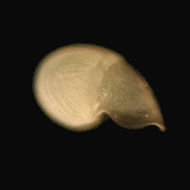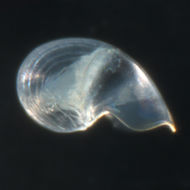-
Lirapex has an unusual type of sculpture consisting of the lineate sculpture typical of peltospirids with numerous tubercles between them, especially near the axis of coiling. Both fade out about halfway to the aperture. When viewed from the bottom under the light microscope, a thick bar running across the shell is visible just posterior to the aperture. The aperture is nearly straight, with a wide rim tapering toward the posterior. The shell is transparent and glassy-looking.
-
Lirapex has an unusual type of sculpture consisting of the lineate sculpture typical of peltospirids with numerous tubercles between them, especially near the axis of coiling. Both fade out about halfway to the aperture. When viewed from the bottom under the light microscope, a thick bar running across the shell is visible just posterior to the aperture. The aperture is nearly straight, with a wide rim tapering toward the posterior. The shell is transparent and glassy-looking.
-
Lirapex has an unusual type of sculpture consisting of the lineate sculpture typical of peltospirids with numerous tubercles between them, especially near the axis of coiling. Both fade out about halfway to the aperture. When viewed from the bottom under the light microscope, a thick bar running across the shell is visible just posterior to the aperture. The aperture is nearly straight, with a wide rim tapering toward the posterior. The shell is transparent and glassy-looking.
-
Pachydermia laevis has a moderately large protoconch with regular overall interconnected reticulate sculpture, strongly marked in the proximal region and becoming finer and less distinct toward the aperture. The aperture is slightly curved with a thickened broad rim that tapers slightly toward the inner edge.
-
Pachydermia laevis has a moderately large protoconch with regular overall interconnected reticulate sculpture, strongly marked in the proximal region and becoming finer and less distinct toward the aperture. The aperture is slightly curved with a thickened broad rim that tapers slightly toward the inner edge.
-
This is one of the few easily identified peltospirids. It is a large protoconch with strong lineation extending about 2/3 of the way to the aperture. Like most peltospirids, the aperture is straight viewed from the side and flares out to the sides when viewed from from the top, as in the third photo above. There is also an abrupt ridge on either side of the base near the axis of coiling. The shell is transparent and robust; they are seldom found damaged.
-
This is one of the few easily identified peltospirids. It is a large protoconch with strong lineation extending about 2/3 of the way to the aperture. Like most peltospirids, the aperture is straight viewed from the side and flares out to the sides when viewed from from the top, as in the third photo above. There is also an abrupt ridge on either side of the base near the axis of coiling. The shell is transparent and robust; they are seldom found damaged.
-
This is one of the few easily identified peltospirids. It is a large protoconch with strong lineation extending about 2/3 of the way to the aperture. Like most peltospirids, the aperture is straight viewed from the side and flares out to the sides when viewed from from the top, as in the third photo above. There is also an abrupt ridge on either side of the base near the axis of coiling. The shell is transparent and robust; they are seldom found damaged.
-
Neomphalus fretterae has a moderately large protoconch with reticulate sculpture over the proximal half of the shell. The distal half is smooth, with the outer edge flaring out above the aperture. The aperture is sinuous and there is a wide rim, tapering toward the inner edge, which is visible under the light microscope.
-
Melanodrymia aurantiaca has a moderately large protoconch entirely covered with irregular reticulate sculpture, giving it a grainy appearance when viewed under a light microscope. The aperture is deeply sinuous and there is a broad ridge or bump at the anterior edge of the shell above the aperture.
-
Melanodrymia aurantiaca has a moderately large protoconch entirely covered with irregular reticulate sculpture, giving it a grainy appearance when viewed under a light microscope. The aperture is deeply sinuous and there is a broad ridge or bump at the anterior edge of the shell above the aperture.
-
This group is quite angular in appearance and has the lines beginning on a raised platform at the base of the shell. In this form the lines become indistinct for most of the shell. The aperture is slightly flared and has a narrow rim. We believe this morphotype corresponds to Echinopelta fistula, which has the same raised platform on the base (see SEM photo above).
-
This group is quite angular in appearance and has the lines beginning on a raised platform at the base of the shell. In this form the lines become indistinct for most of the shell. The aperture is slightly flared and has a narrow rim. We believe this morphotype corresponds to Echinopelta fistula, which has the same raised platform on the base (see SEM photo above).
-
This group is quite angular in appearance and has the lines beginning on a raised platform at the base of the shell. In this form the lines become indistinct for most of the shell. The aperture is slightly flared and has a narrow rim. We believe this morphotype corresponds to Echinopelta fistula, which has the same raised platform on the base (see SEM photo above).
-
This is a moderately large protoconch with overall fine reticulate sculpture. The anterior edge flares at the aperture, which is strongly sinuous.
-
Cyathermia naticoides has a moderately large protoconch. The posterior is covered by coarse reticulate sculpture which gives the appearance of bubbles under the light microscope. The anterior portion is smooth. The aperture is slightly sinuous and there is a medium-width rim.
-
Cyathermia naticoides has a moderately large protoconch. The posterior is covered by coarse reticulate sculpture which gives the appearance of bubbles under the light microscope. The anterior portion is smooth. The aperture is slightly sinuous and there is a medium-width rim.
-
This protoconch has approximately 16-18 lines, beginning in a V at the axis of coiling and following the curvature of the shell, stopping abruptly at the same point about 2/3 of the way to the aperture. The aperture is perfectly circular when viewed from the bottom and is surrounded by a narrow rim which flares out to the sides when viewed from the top. It looks more streamlined than most peltospirids, since it is shorter for its diameter and the base is more smoothly rounded. It matches the SEM of Peltospira operculata in Mullineaux et al. (1996) in size and general appearance, but is also very similar to the Nodopelta subnoda protoconch (SEM, Desbruyères et al. (2006) p. 117). Molecular work is ongoing and may help to resolve the issue. In the meantime, we have attributed this protoconch to Peltospira, as it is the most common genus at 9°N.
-
This protoconch has approximately 16-18 lines, beginning in a V at the axis of coiling and following the curvature of the shell, stopping abruptly at the same point about 2/3 of the way to the aperture. The aperture is perfectly circular when viewed from the bottom and is surrounded by a narrow rim which flares out to the sides when viewed from the top. It looks more streamlined than most peltospirids, since it is shorter for its diameter and the base is more smoothly rounded. It matches the SEM of Peltospira operculata in Mullineaux et al. (1996) in size and general appearance, but is also very similar to the Nodopelta subnoda protoconch (SEM, Desbruyères et al. (2006) p. 117). Molecular work is ongoing and may help to resolve the issue. In the meantime, we have attributed this protoconch to Peltospira, as it is the most common genus at 9°N.
-
This protoconch has approximately 16-18 lines, beginning in a V at the axis of coiling and following the curvature of the shell, stopping abruptly at the same point about 2/3 of the way to the aperture. The aperture is perfectly circular when viewed from the bottom and is surrounded by a narrow rim which flares out to the sides when viewed from the top. It looks more streamlined than most peltospirids, since it is shorter for its diameter and the base is more smoothly rounded. It matches the SEM of Peltospira operculata in Mullineaux et al. (1996) in size and general appearance, but is also very similar to the Nodopelta subnoda protoconch (SEM, Desbruyères et al. (2006) p. 117). Molecular work is ongoing and may help to resolve the issue. In the meantime, we have attributed this protoconch to Peltospira, as it is the most common genus at 9°N.
-
This is the largest peltospirid protoconch we have found at EPR. Lineate sculpture, narrowly spaced, covers the posterior half of the protoconch. The anterior portion is smooth. The aperture is deeply sinuous, unlike all other peltospirids we have found.
-
This is the largest peltospirid protoconch we have found at EPR. Lineate sculpture, narrowly spaced, covers the posterior half of the protoconch. The anterior portion is smooth. The aperture is deeply sinuous, unlike all other peltospirids we have found.

